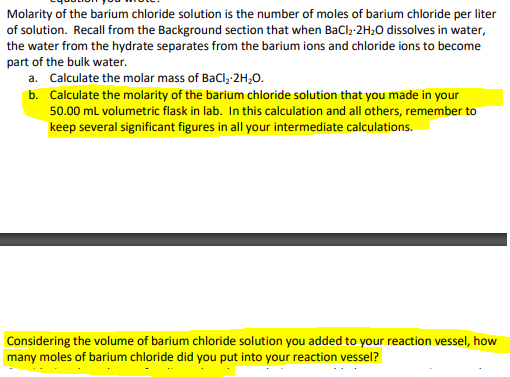b. Calculate the molarity of the barium chloride solution that you made in your 50.00 ml volumetric flask in lab. In this calculation and all others, remember to keep several significant figures in all your intermediate calculations. Considering the volume of barium chloride solution you added to your reaction vessel, how many moles of barium chloride did you put into your reaction vessel?
b. Calculate the molarity of the barium chloride solution that you made in your 50.00 ml volumetric flask in lab. In this calculation and all others, remember to keep several significant figures in all your intermediate calculations. Considering the volume of barium chloride solution you added to your reaction vessel, how many moles of barium chloride did you put into your reaction vessel?
Chemistry: Principles and Practice
3rd Edition
ISBN:9780534420123
Author:Daniel L. Reger, Scott R. Goode, David W. Ball, Edward Mercer
Publisher:Daniel L. Reger, Scott R. Goode, David W. Ball, Edward Mercer
Chapter12: Solutions
Section: Chapter Questions
Problem 12.98QE
Related questions
Question
I only need answers for the highlighetd portions.
This was a lab I performed in my chemistry, it was using vaccum filtration to collect solids from a Barium Chloride solution (BaCl2*2H2O). I took 0.780g of Barium Chloride. I added 25ml of water it at first, then transferred it to a 50ml flask and filled it to 50ml and completely mixed the solution. Then I took 38ml of Na3PO4 and mixed it with the 50ml BaCl2 solution into a 250ml beaker. After mixing those, I filtered it out and collected the solids.

Transcribed Image Text:Molarity of the barium chloride solution is the number of moles of barium chloride per liter
of solution. Recall from the Background section that when BaCl,-2H20 dissolves in water,
the water from the hydrate separates from the barium ions and chloride ions to become
part of the bulk water.
a. Calculate the molar mass of BaCl, 2H,0.
b. Calculate the molarity of the barium chloride solution that you made in your
50.00 ml volumetric flask in lab. In this calculation and all others, remember to
keep several significant figures in all your intermediate calculations.
Considering the volume of barium chloride solution you added to your reaction vessel, how
many moles of barium chloride did you put into your reaction vessel?
Expert Solution
This question has been solved!
Explore an expertly crafted, step-by-step solution for a thorough understanding of key concepts.
This is a popular solution!
Trending now
This is a popular solution!
Step by step
Solved in 3 steps with 2 images

Knowledge Booster
Learn more about
Need a deep-dive on the concept behind this application? Look no further. Learn more about this topic, chemistry and related others by exploring similar questions and additional content below.Recommended textbooks for you

Chemistry: Principles and Practice
Chemistry
ISBN:
9780534420123
Author:
Daniel L. Reger, Scott R. Goode, David W. Ball, Edward Mercer
Publisher:
Cengage Learning

Principles of Modern Chemistry
Chemistry
ISBN:
9781305079113
Author:
David W. Oxtoby, H. Pat Gillis, Laurie J. Butler
Publisher:
Cengage Learning

Chemistry by OpenStax (2015-05-04)
Chemistry
ISBN:
9781938168390
Author:
Klaus Theopold, Richard H Langley, Paul Flowers, William R. Robinson, Mark Blaser
Publisher:
OpenStax

Chemistry: Principles and Practice
Chemistry
ISBN:
9780534420123
Author:
Daniel L. Reger, Scott R. Goode, David W. Ball, Edward Mercer
Publisher:
Cengage Learning

Principles of Modern Chemistry
Chemistry
ISBN:
9781305079113
Author:
David W. Oxtoby, H. Pat Gillis, Laurie J. Butler
Publisher:
Cengage Learning

Chemistry by OpenStax (2015-05-04)
Chemistry
ISBN:
9781938168390
Author:
Klaus Theopold, Richard H Langley, Paul Flowers, William R. Robinson, Mark Blaser
Publisher:
OpenStax

Chemistry & Chemical Reactivity
Chemistry
ISBN:
9781337399074
Author:
John C. Kotz, Paul M. Treichel, John Townsend, David Treichel
Publisher:
Cengage Learning

Chemistry: An Atoms First Approach
Chemistry
ISBN:
9781305079243
Author:
Steven S. Zumdahl, Susan A. Zumdahl
Publisher:
Cengage Learning

Chemistry: Principles and Reactions
Chemistry
ISBN:
9781305079373
Author:
William L. Masterton, Cecile N. Hurley
Publisher:
Cengage Learning